The gods of northern Buddhism
their history, iconography and progressive evolution through the northern Buddhist countries
by Alice Getty | 1914 | 98,662 words
Indispensable reference for art historians, scholars of Eastern philosophy and religion. Wealth of detailed scholarly information on names, attributes, symbolism, pictorial representations of virtually every major and minor divinity in Mahayana pantheon, as worshipped in Nepal, Tibet, China, Korea, Mongolia, and Japan. 185 black-and-white illustrat...
Chapter XIII - Forms Of Kuvera
Kuvera (or Kubera) or Vaisravana (his patronymic)
God of Wealth.
Guardian of the North.
(T.) rnam-t'os-sras (Nam-toi-sre) (son of rnam-t'os).
(M.) Unman tegri (the god Bisman).
(C.) Ts'ai-shen (![]() ) or To-wen.
) or To-wen.
(J.) Bislmmon.
Special symbol: nakula [1] (mongoose vomiting jewels).
Symbols: trident, dhvaja (banner), lai-bwmpa (flat vessel, &c).
Colour: yellow.
Vahana: pushpaka (self-moving chariot), elephant or lion.
Sakti: Vasudhara.
As Dharmapala (Drag-ched): Kuvera or Vaisravana.
As Yi-dam: Jambala (Dsambhala).
Special symbol: jambhara (lemon).
Symbol: nakula (mongoose).
According to Hindu mythology Kuvera was the son of a sage called 'Visravas', hence his patronymic, Visravana or Vaisravana. He is said to have performed austerities for a thousand years, in reward for which Brahma gave him immortality and made him god of Wealth, guardian of all the treasures of the earth, which he was to give out to whom they were destined.
Kuvera also became one of the Lokapala, or Regents of the Four Cardinal Points, who were likewise guardians of Mount Sumeru, the centre of the universe. His city was Alaka in the Himalayas, abounding in wealth and magnificence, where he was attended by the Yakshas [2] and the horse-headed men called 'Kinnaras'. According to some accounts, Kuvera's abode was on Mount Kailas, [3] while others state that when Brahma appointed him god of Riches, he gave him Lanka (Ceylon) as his capital, and, according to the Maliabharata, presented him with the car, pushpaka, which was of immense size, and 'moved at the owner's will at marvellous speed'.[4]
It is believed that the name 'Kuvera' may be a corruption of the word kutana (vile body), in reference to his ugliness, for, according to Hindu mythology, he had three heads, three legs, eight teeth, green eyes, and a white leprous body. He wore a crown and carried a mace, and was covered with jewels.
The representations, however, of Kuvera do not follow the tradition of three legs, either in Nepal or India. In fact, a statue of Kuvera found at Gandhara [5] might be taken for a Roman emperor, were it not for the kneeling youth at his feet pouring out money from a long narrow bag under his arm, which is in the shape of the traditional mongoose of Northern Buddhism; but the images from the Magadha follow more closely the corpulent, self-complacent god of the Mahayana Pantheon.
Kuvera has no worship in India. He is mentioned in very ancient texts, but, unfortunately, without reference to his symbols. Statues of him in Nepal date back to the eleventh century, while in India, in the Magadha, they are much earlier, and it is believed that the most ancient statues of Mahakala (the Great Black One) were in reality but statues of Kuvera, for in Nepal they held the mongoose, and in India the long narrow bag of gold.
The Lamas claim that the mongoose symbolizes Kuvera's victory over the Nagas, guardians of the treasures. The nakula, however, is merely a bag made of the skin of a mongoose, replacing the long narrow sack of the earlier images. In Java, according to Oldenburg, the long narrow sack is rarely finished by the head of a mongoose as it is in the Magadha, but the neck is left open resembling a mouth. [6]
Kuvera has both Yi-dam and Dharmapala forms. As Yi-dam he is called Jambala, probably from the jambhara (lemon) this form always carries in his right hand. Under his left arm is the usual mongoose, vomiting jewels. [7] With but very few exceptions, of which one is in the British Museum, only the Jambala form of Kuvera carries the large mongoose under the arm, while all the other forms hold on the palm of the left hand a small mongoose with a single jewel in its mouth.
There is an example of Kuvera in a crouching position holding a Kapala in the right hand, while the left rests on the neck of a mongoose which hangs over the left knee. He wears serpent ornaments, and in his head-dress is the small image of a Dhyani-Buddha.
Kuvera is always represented corpulent and covered with jewels. His right foot is generally pendent and supported by a lotus-flower on which is a conch shell, or a hi-bumpa, a low, flat vessel used in the Lamaist ceremonies as an object of contemplation, to procure perfection in abstract thought. The vessel is usually represented overturned, with jewels sometimes issuing from it and falling over the lotus-throne. The conch-shell may also be supported by a vase. He may also carry a vase somewhat in the shape of an ambrosia vase under his right arm.
According to Oldenburg, his foot may rest on a bag of precious things supported by a lotus-flower.
His Dharmapala form is called 'Kuvera', and he is either represented sitting on a lion [8] (white, with green mane), or on several cushions called Kholbok, [9] the number of cushions indicating the rank given him. He may also be seated on a horse [10] (PI. xlviii, fig. a), and Grunwedel mentions a form sitting or standing on a demon. [11] He carries the dhvaja, or victorious banner, or a trident, in his right hand, and a small mongoose, with a jewel in its mouth, in the palm of his left hand. According to Schlagintweit, he is accompanied by eight Vaisravanas, each with his own special symbol in his right hand: a jewel, a sword, a lai-bumpa, a small shrine several stories high, called khangtsig, &c. They all carry, in the left, a small mongoose with a jewel in its mouth.
Kuvera may have a third eye, and is often represented with a closely cut beard under the chin, reaching from ear to ear. He is found in a triad with the Dipahkara Buddha and Mania, Buddha of Medicine.
There is a special ceremony in Tibet for imploring Kuvera for riches, which is called Yanyung, and he plays an important part in the Tantras, in sorcery and exorcism.
The illustration on PI. xlix is a bronze which, as far as the author knows, is unique, and might possibly be a representation of the Tantra form of Kuvera. Its three legs agree with the description of Kuvera in Hindu mythology, but there are five heads instead of three, one on either side of the central head, and one above the central one (all of which have the third eye and an angry expression). The second head above the central one (which would be Ratnasambhava if the god is Kuvera) has a sweet expression. The hair stands upright from the heads, in flame shape, forming a nimbus for the two upper heads. He has eight arms. The two normal arms are in vajra-hum-kara mudra (crossed on the breast), and the hands hold kapdla (skull-cups) which are supported by the arms from underneath. The other hands hold the ghanta, (bell), vajra (thunderbolt), and grigug (chopper). The hips are covered by a human skin and the feet of the three legs rest on skulls. The necklets, bracelets, and anklets are snakes.
Kuvera is also one of the four Lokapala which are supposed to inhabit the lowest compartments of the heavens, guarding the regions assigned them from the wicked spirits called Asuras. Each has an immortal elephant, eight generals, and an army of demons, and all are worshipped with fervour by the common people as well as by the priests.
For his Chinese and Japanese forms v. Lokapala.
(T.) rta-mgrin (pro. tam-din) (lit. 'with the voice of a horse').
(M.) morin qogholai-tu (with the voice of a horse).
(C.) Pi-mih-ma-t'en-kin-kang.
(J.) Ba-to Kioan-non.
Symbols: vajra (thunderbolt), beng (mace).
Colour: red or dark brown.
Sakti: Marlcl (light blue).
Distinctive mark: horse's head in head-dress.
Hayagriva, as a Dharmapala, has the rank of Bodhisattva, but, according to Grunwedel, [12] may also take a Yi-dam form, in which case he would have the rank of a Buddha.
He is worshipped in Tibet principally by the horse-dealers, for, although he is not the god, Protector of Horses, he is believed to frighten away the demons by neighing like a horse. When invoked, he is said to announce his coming by neighing, which may account for the presence of a horse's head, his distinctive mark, in his head-dress.
The horse is one of the Sapta Ratna (the Seven Precious Things), and Lungta, the 'airy horse', is extremely popular among the nomadic tribes of Tibet, as he may be invoked without the intervention of a lama. Schlagintweit says,
'The efficacy of any dharanl, or mystical sentence, for happiness in this existence is supposed to become more certain by the presence of Lungta; and from this belief it has become customary to add to the dharani a horse supporting the precious stone Norbu, or a figure, allegorical of the horse, or at least an address directed to Lungta'. [13]
Hayagrlva's popularity may therefore possibly be attributed to the usual presence of the horse's head in his dishevelled hair, but it is sometimes missing.
In his most simple form he is normal, and swings a sword in his right hand and holds a lasso in the other. His hair is dishevelled, and protruding from it is a horse's head. He wears a crown of skulls, and under a belt of heads hangs a tiger-skin. He may have one head and four arms, in which case his upper hands hold the mace (on the top of which may be a skull) and a flower. The lower left hand holds a wheel (or lasso) against the breast. The right hand makes a mystic mudra and he steps to the right on a lotus-throne.
There is a form with three heads, four arms, and four legs, which is believed to be his manifestation when invoked by the Indian Pandit Atisa, who was invited by the Tibetan king in the tenth century a. d. to reform the Northern Buddhist faith in Tibet. He is represented like the above with dishevelled hair, crown of skulls, belt of heads, and a tiger-skin covering. The upper hands hold a thunderbolt and a flower, the lower hands draw the bow. He steps to the right on demons.
He may have still another form with three heads, six arms, and eight legs. His symbols are the thunderbolt, trident, lasso, &c, and from his dishevelled hair may protrude three horses' heads (PI. xliv, fig. d).
Hayagriva may have garuda wings. In this form he has three heads, a third eye, a necklace of heads, wears a lion's and elephant's skin, and steps to the right on demons. He has six arms, the upper hands holding the double thunderbolt and sword, the next the mace and khatvanga (magic stick). The lower arms encircle the ktkti if he is in yab-yum attitude, and hold the JcapCda (skull-cup) in the left, while the right is in mystic mudra. The kikti has a crown of heads, a third eye, and holds a skull-cup and a flower. She encircles the yab with her legs, and her mouth almost touches the tongue of the god. If painted, she is light blue (PL xliv, fig. c).
In the miniatures Hayagriva is never represented otherwise than as an assistant. According to M. Foucher, a form of the god found in the sadliana has three heads: the first blue, showing the tongue; the second, red and smiling; the third, white, biting its lips. They are placed one on either side of the central head, which is red. He has eight arms, and carries a thunderbolt, mace, flower, lotus, bow, and arrow, and two hands make a mystic gesture. In his hair is a small image of Akshobhya.
The phur-bu, [14] magic dagger, is believed to be a form of Hayagriva.
Hayagriva with Tara, Sudhanakumara, and Bhrikuti often accompany Avalokitesvara, in which case Hayagriva is always at his left.
His manifestation in Japan is apparently Ba-to Kwan-non, [15] for the resemblance is too close to admit of any doubt. In China he seems to have been little known.
Mahakala (Dharmapala)
The Great Black One.
(T.) mgon-po (the protector), or nag-po c'en-po (the Great Black One).
(M.) jeke qara (the Great Black One).
(C.) Ta-shen-wang (![]() ).
).
(J.) Dai-ko-ku.
Special symbol: trisula (trident).
Colour: black (or dark blue) or white.
Distinctive mark: treads on one or two elephants.
One of the 'Eight Terrible Ones' (Drag-ched).
It is claimed that Mahakala, holding the trident, is no other than a form of the Greek god Poseidon [16] copied from Indo-Scythian coins; but it seems also possible that he is merely the result of a misnomer; in other words, that Mahakala and Kuvera are one and the same divinity. Yi-tsing, the Chinese author and pilgrim, relates that at the doors of the Indian monasteries there was usually the statue of a deity, seated, with one leg pendent, holding a bag of gold. He further says that this god was called 'Mahakala' (the Great Black One), because he was blackened by the oil constantly poured over him by the faithful in performing puja. [17] This description of the god assuredly indicates Kuvera; [18] and the Nepalese Mahakala, holding a mongoose under his arm, resembles Kuvera even more closely. The Tibetan form of Mahakala, however, is definite and in no way resembles Kuvera, although one of his manifestations is called 'god of wealth'.
The tutelary god of Mongolia is Mahakala, but he was not popular until the sixteenth century, when the Dalai-lama, mK'asgrub of Lhasa, was summoned to the court of Altan Khan, and so influenced the king that all non-Buddhist idols were burned, and the six-armed Mahakala was proclaimed Protector of the Mongolian Buddhists.
Mahakala may be both Yi-dam and Dharmapala, and has innumerable forms; but they may all be classed under four heads, or five, if we include the special manifestation of mGon-po Bramzei.
Mahakala Son-dkar, god of Wealth, is the special protector of the Mongolian Buddhists. He has one head, which is sometimes deformed to resemble a bull, his hair stands upright behind the crown, flame-shaped, he has the third eye, and his expression is angry. He has six arms. The cintamani (magic jewel) is in the hand of his right (original) arm and is held against his breast. In the left is a kapala (skullcup) held underneath the magic jewel. The other four hands hold chopper, small drum, trident, and elephant goad. He has an elephant-skin covering, and a scarf rises stiffly from his shoulders, almost forming a nimbus around his head. He stands on two elephants, and, if painted, he is white (PI. L, figs, c and d).
Mahakala mSon-po resembles the white Mahakala with the exception of two symbols. Instead of the cintamani, he holds a grigug in his original right hand. The other four symbols are: a rosary of skulls, a trident, a lasso, and a disc. His two upper arms hold an elephant-skin over his shoulders. He wears a belt of heads, and steps to the right on a prostrate elephant-headed god, the demon Vinataka (Brahman god Ganesa), who holds a flower in one hand and either a skull-cup or rat in the other. If painted, he is dark blue. This form is also popular in Mongolia (PI. Li).
There is an unusual example of this form with only two arms. The right holds a sword and the left is in a mystic mudra. He stands on an elephant-headed personage. In his hair is a small image of a Dhyani-Buddha (PI. l, fig. a).
Mahakala, Protector of Science, is seated on a personage and has one leg pendent. He has four arms. His symbols are: trident, sword, skull-cup, and a fruit. He is dark blue.
Mahakala, Protector of the Tent, holds a grigug (chopper) and lasso, and horizontally on his arms he balances a stick. He treads on a personage and is dark blue.
mGonpo Bramzei is a special form taken by Mahakala to manifest himself to the great lama Pago-pa in the thirteenth century, when he was called to the Imperial court to convert the Emperor Koubilai, who was already conversant with the sutra of the Hevajra-tantra. Pago-pa, on the contrary, had never seen this sutra, and finding it impossible to reply to the questions of the emperor, begged that the discussion be put off until the next day. That night, while in utter despair at being unable to get hold of the Hevajra-tantra, there appeared, to his astonishment, an old white-haired Brahmana, who told him to arrange his lamp and then put before him the coveted sutra. He was thus able to confer with the emperor on the following day and convert him. The old Brahmana was none other than Mahakala under the form of —
mGonpo Bramzei (Mahakala Brahmanarupa). In this form he has one head and wears a long white beard. He may have a third eye. In his right hand is a trumpet made of a human thigh-bone, and in the left is a hapala full of blood. Around his left arm is a rosary of skulls. He may step to the right on a personage or be kneeling on him, in which case he holds the trumpet to his mouth.
In Japan, Dai-ko-ku, god of Wealth, has a form which in no way resembles the Tibetan Mahakala, for he is represented as a very fat, jolly-faced man, always seated, and with a huge bag of grain at his side. He is the Japanese form of the Mahakala Son-dkar.
YAMANTAKA (Dharmapala) Conqueror of Death (Yama).
(T.) gsin-rje-gsed (exterminator of the Lord of Death), or hjegs-byed (he who causes fear).
(M.) erlig-jin jarghaqci (exterminator of Erlik).
(C.) Yen-man-te-kia (![]() ).
).
Symbols: grigug (chopper), kapala (skull-cup).
Colour: red (when alone), black or dark blue.
Distinctive mark: bull's head.
Different names: Sri vajrabhairava, Vajrabhayankara, Vajrabhairava, Bhairava, and Yamsri.
One of the 'Eight Terrible Ones' (Dharmapala or Drag-ched).
Yi-dani of the Ge-lug-pa (Yellow Bonnet) sect. [19]
Yamantaka, the ferocious emanation of Manjusri, is the most complicated and terrible of all the Northern Buddhist divinities. Under this form he conquered the demon king of Death, Yama, who was depopulating Tibet in his insatiable thirst for victims.
Both Yama and Yamantaka are represented with bulls' heads, but Yama always has an ornament, shaped like a wheel, on his breast, which is his distinctive mark.
Yamantaka as Vajrabhairava may be represented with a human head. According to Vidyabhusana, [20] in his description of certain Tibetan scrolls found in a monastery near Gyantse, Vajrabhairava
'possesses a disproportionately large head, scowling brows, three cruel eyes, and a gaping mouth, showing canine fangs and rolling tongue'.
Nor does he figure with a bull's head in the two sadhana mentioned by M. Foucher, [21] for in the first he has six faces, and in the second one face.
The simplest form of Yamantaka has one head (a bull's) and two arms. He has a crown of skulls and the third eye. In his right hand is a chopper and in his left a skull-cup (kapala). He has a belt of heads and steps 1o the right (PI. lii, fig. a).
In the Srimahdvajrabhairava tantra there is a detailed account of the way Yamantaka should be represented if painted. [22] He is to have sixteen feet, thirty-four arms, nine heads, is naked and black; he steps to the right, and his aspect is more than terrible. The first head is that of a bull. Next to the right horn, he must have three heads: blue, grey, and black (description of three heads on left side omitted). Between the horns must be painted a head, red and terrible, above which must be the head of Manjusri with a slightly irritated expression. The hands hold all the Tantra symbols (list given in the tantra). The right feet tread on animals and the left on birds. In the bronzes Yamantaka may be treading on demons, under which are animals and birds, or the reverse, or the demons may be supporting the throne as in the accompanying illustration (PI. lii, fig. d).
Yamantaka has a skull diadem, a belt of heads, a third eye, and steps to the right. He may have five heads, and hold the skin of a human being over his shoulders. He is usually represented with his sakti (PI. lii, fig. c).
As Yamari, however, he is not represented with a &akti. In this form Yamantaka holds a sceptre topped by a skull in his right hand and a kapala in his left, and steps to the right on a corpse, under which is a bull.
| PLATE L | ||
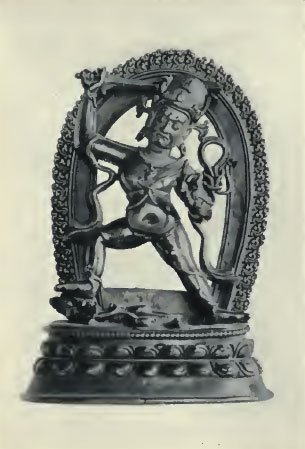 |
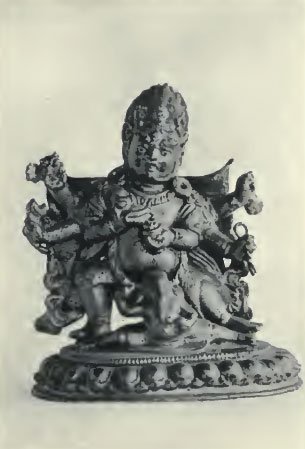 |
|
| a. Mahakala | b. Mahakala | |
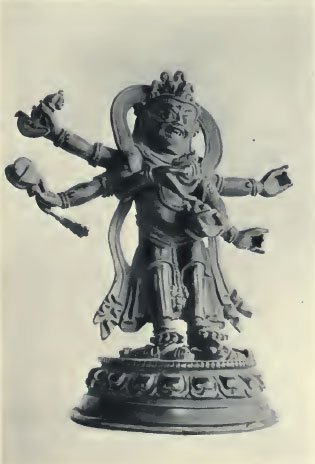 |
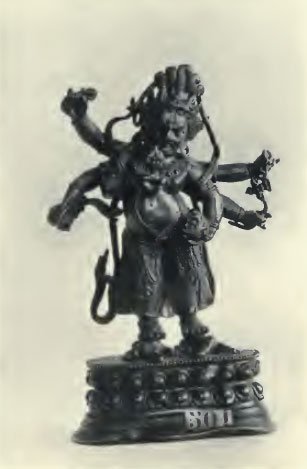 |
|
| c. Mahakala | d. Mahakala | |
| Plate LI |
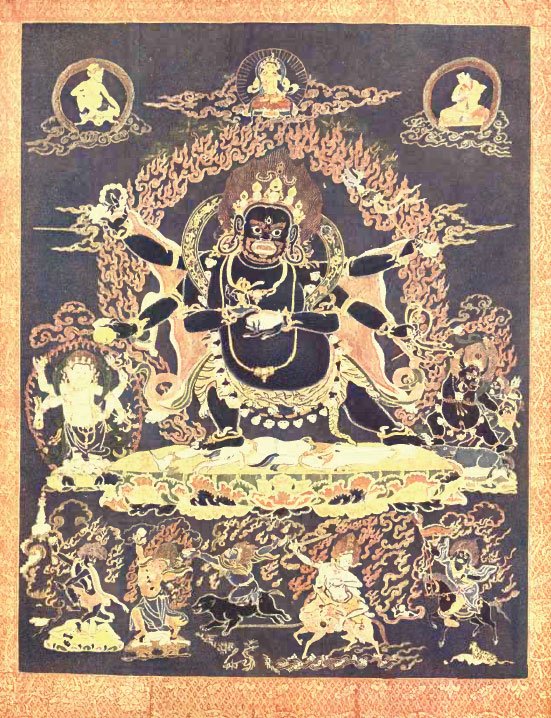 |
| Mahakala |
| PLATE LII | ||
.jpg) |
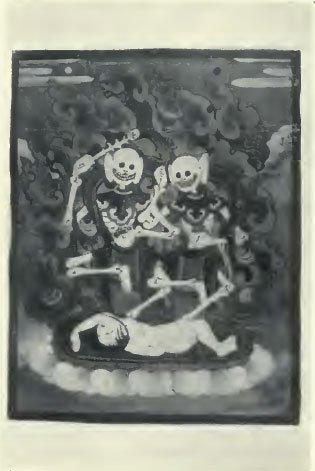 |
|
| a. Yamantaka | b. Citipati | |
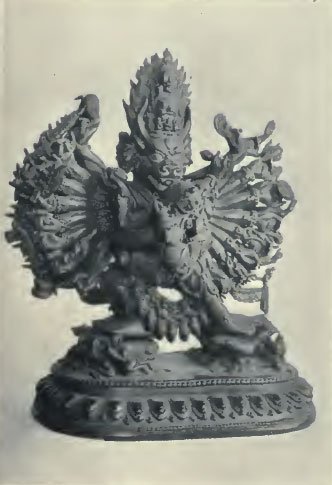 |
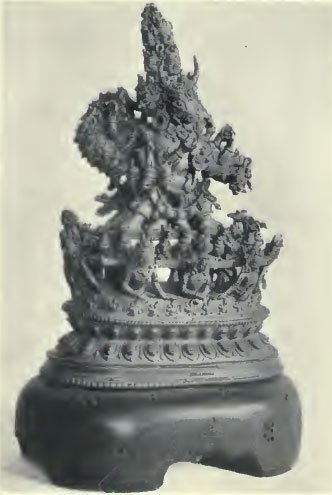 |
|
| c. Yamantaka | d. Yamantaka | |
| PLATE LIII | ||
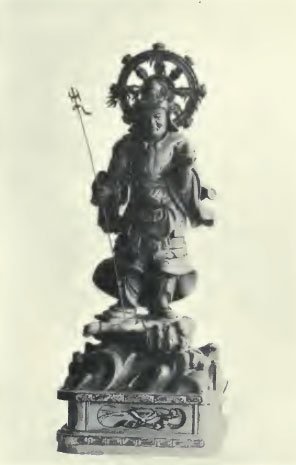 |
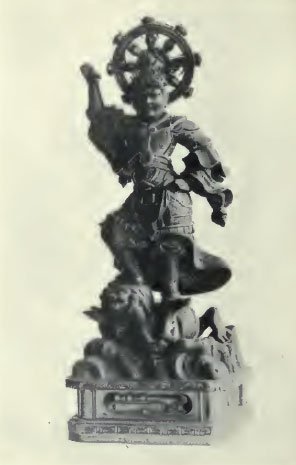 |
|
| a. Bishamon | b. Lokapala | |
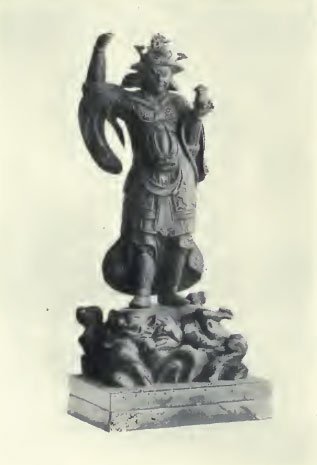 |
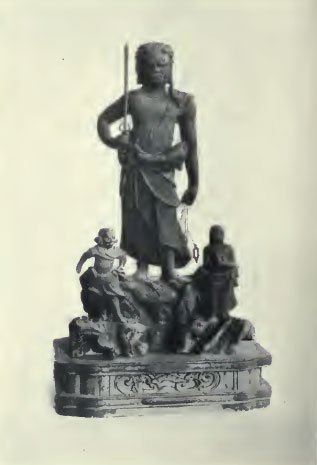 |
|
| c. Bishamon | d. Fudo | |
Footnotes and references:
[1]:
Nakula (Chin. No-ku-lo) is also the name of the fifth of the eighteen Lohans or Sthaviras, disciples of Buddha, and his sphere of action was Jambudvipa (India). His name is found enrolled in the list of gods in the Chinese, Japanese, and Korean temples, and he is represented in Tibetan temple pictures with a mongoose under his arm, or in his hand, or holding a three-legged frog. T. Watters, Eighteen Lolmns of Chinese Buddhist Temples, Shanghai, 1899.
[2]:
Cannibal demons.
[3]:
Presumably the synonym of Mount Sumeru.
[4]:
Wilkins, Hindu, Mythology.
[5]:
v. Grumvedel, MythologieduBouddhisme, illust., p. 24, fig. 14.
[6]:
Oldenburg, A propos de I'histoire du type des images de Kuvera avec Nakula. Publications du Musee d'Anthropologie et d'Ethnologie, St-Petersbourg, 1903, vol. iv. In the Musee Guimct, however, there are five examples of the Javanese Kuvera, where the mongoose is represented in the usual manner. In the British Museum there is a bronze with the nakula holding a purse in its mouth.
[7]:
PI. xlviii, fig. d.
[8]:
PI. xlviii, fig. b.
[9]:
PI. xlviii, fig. c.
[10]:
In one of the miniatures in the Nepalese M S. Add. 1643, in the University Library, Cambridge, there is a personage seated on a horse at the foot of Avalokitesvara, and holds an object, which may be a mongoose, in his hand.
[11]:
Called nara-va/uma, PI. xliv, fig. d.
[12]:
Mythologie da Bouddhisme, p. 166.
[13]:
Buddhism in Tibet, p. 254.
[14]:
v. Phur-bu.
[15]:
v. Ba-to Kwan-non.
[16]:
Grunwedel, Mythologie, p. 24.
[17]:
A. Foucher, Iconographie bouddhique, p. 126.
[18]:
v. Kuvera.
[19]:
Grunwedel, Mythologie, p. 100.
[20]:
Memoirs of the Asiatic Society of Bengal.
[21]:
Iconographie bouddhique, vol. ii, p. 56.
[22]:
Grunwedel, Mythologie, p. 104.
